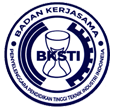An Assessment of Vehicle Transport-Induced Air Pollution along a Traffic Corridor in Lagos
Abstract
Keywords
Full Text:
PDFReferences
Ackerman, M., Davies, T., Jefferson, C., Longhust, J., Marquez, J. (2002). Comparison of diesel and hybrid vehicle emissions by computer modeling, Advances in Transport, Urban Transport VIII: Urban Transport and the Environment in the 21st Century, 8, 471-480. https://doi.org/10.2495/UT020461
Adelugba A.O. (2007). An assessment of transport-induced air pollution: A case study of the Iyana Ipaja-Ikotun Traffic Corridor, B.Sc. Research Project, Department of Geography, University of Lagos, Nigeria.
Bailey, P.D. (1995). Modelling future vehicle exhaust emission in Europe, Water, Air and Soil Pollution, 85(4), 1879-1884. https://doi.org/10.1007/BF01186108
Becker, K.H., Lorzer, J.C. (1999). Nitrogen oxide emission from vehicles, Environmental Science and Technology, 33, 4134. https://doi.org/10.1021/es9903330
Bono, R., Bugliosi, E.H., Schiliro, T., Gilli, G. (2001). The Lagrange street storey: the prevention of aromatics air pollution during the last nine years in a European city, Atmospheric Environment, 35(1), 107-113. https://doi.org/10.1016/S1352-2310(01)00085-1
Broderick, B.M., Budd, U., Misstear, B.D., Beburnis, D.; Jennings, S.G. (2005). Validation of CALINE 4 modeling for carbon monoxide concentrations under free-flowing and congested traffic conditions in Irelands, International Journal and Environment and Pollution, 24(1-4), 104-113. https://doi.org/10.1504/IJEP.2005.007388
Chang, J.P., Levy, C., Fontelle, P. (2001). New estimation of air traffic emission in France: trends and comparison with other transport modes, International Journal of Vehicle Design, 27(1-4), 20-30. https://doi.org/10.1504/IJVD.2001.001948
Dasch, J.M., 1992, Nitrous oxide emissions from vehicles, Journal of Air and Waste Management Association, 42, 63.
De Rosa, M. (2003). Traffic pollution damages men’s sperm, Journal of Human Reproduction (Vancouver Indymedia), 18, 1055.
Fattah M.A., Morshed S.R. (2021). Assessing the sustainability of transportation system in a developing city through estimating CO2 emissions and bio-capacity for vehicular activities, Transportation Research Interdisciplinary Perspectives, 10, Article 100361. https://doi.org/10.1016/j.trip.2021.100361
Favrel, V. and Heckq, W. (2001). External costs of air pollution generated by road traffic in the Brussels urban area, International Journal of Vehicle Design, 27(1-4), 129-139. https://doi.org/10.1504/IJVD.2001.001958
Gehrig, R., Hill, M., Buchmann, B., Imhof, D., Weingartner, E., Battensperger, U. (2004). Separate determination of PM10, emission factors of road traffic for tailpipe emissions from abrasion and resuspension processes, International Journal of Environment and Pollution, 22(3), 312-325. https://doi.org/10.1504/IJEP.2004.005549
Gibbs, D.P., Betty, C.L., Dolaty, M., Angento, V. (1995). Use of infra-red and ultraviolent spectrometers to measure the vehicle emission on urban air quality, Proceedings of SPIE – the International Society for Optical Engineering, 2365, 84-93.
Giri, J., Raut, S., Rimal, B., Adhikari, R., Joshi, T.P., Shah, G. (2023). Impact of air pollution on human health in different geographical locations of Nepal, Environmental Research, 226, Article 115669. https://doi.org/10.1016/j.envres.2023.115669
Glen, W.G., Zelenka, M.P., Graham, R.C. (1996). Relating meteorological variables and trends in motor vehicle emissions to monthly urban carbon monoxide concentrations, Atmospheric Environment, 31(24), 4225-4232. https://doi.org/10.1016/1352-2310(96)00130-6
He, D., Wang, M., Thomas, A. (2007). Air pollution challenges and solutions for China’s urban transportation development, International Journal of Environment and Pollution, 30(1), 154-171. https://doi.org/10.1504/IJEP.2007.014509
Hesek, F. (2001). Modeling of air pollution from road traffic, International Journal of Environment and Pollution, 16(1-6), 366-373.
Holguin, F. (2008). Traffic, outdoor air pollution and asthma, Allergy Clinics of North America, 28(3), 577-588. https://doi.org/10.1016/j.iac.2008.03.008
Huang, H., Ooka, R., Chen, H., Kato, S., Takahashi, T., Watanabe, T. (2008). CFD analysis on traffic-induced air pollutant dispersion under non-isothermal condition in a complex urban area in winter, Journal of Wind Engineering and Industrial Aerodynamics, 96(10/11), 1774-1778. https://doi.org/10.1016/j.jweia.2008.02.010
Johnson, L., Jamriska, M., Morawska, L., Ferreira, L. (2000). Vehicle emissions in Australia: from monitoring to modeling, Advances in Transport, Urban Transport VI: Urban Transport and the Environment for the 21st Century, 6, 469-478.
Karlsson, H.L. (2004). Ammonia, nitrous oxide and hydrogen cyanide emissions from five passenger vehicles, Science of the Total Environment, 334/335, 125-132. https://doi.org/10.1016/j.scitotenv.2004.04.061
Lin, J., Yu, D. (2008). Traffic-related air quality assessment for open road tolling highway facility, Journal of Environmental Management, 88(4), 962-969. https://doi.org/10.1016/j.jenvman.2007.05.005
Lilley, L.C. (2000). A new approach to emissions inventory modeling-assessing fuel and vehicle impacts on air quality, Advances in Air Pollution, 8, 389-398. https://doi.org/10.2495/AIR000391
Mazzoli-Rocha, F., Magalhaes, C.B., Malm, O., Hilario, P., Saldiva, N., Zin, W.A., Faffe, D.S. (2008). Comparative respiratory toxicity of particles produced by traffic and sugarcane burning, Environmental Research, 108(1), 35-41. https://doi.org/10.1016/j.envres.2008.05.004
Menz, F.C. (2002). The US experience with controlling motor vehicle pollution: lessons for China, International Journal of Environment and Pollution, 18(1), 1-21. https://doi.org/10.1504/IJEP.2002.000691
Mukhopadhyay, B.K., Roy, A.K. (2006). A study on some standard mathematical modeling on automobiles and environmental pollution in the city of Kolkata, International Journal of Environment and Pollution, 28(1/2), 198-215. https://doi.org/10.1504/IJEP.2006.010884
Nethery, E., Teschke, K., Brauer, M. (2008). Predicting personal exposure of pregnant women to traffic-related air pollutants, Science of the Total Environment, 395(1), 11-22. https://doi.org/10.1016/j.scitotenv.2008.01.047
Ojolo S.J., Oke S.A., Dinrifo R.R., Eboda F.Y. (2007). A survey on the effects of vehicle emissions on human health in Nigeria, Journal of Rural and Tropical Public Health, 6, 16–23.
Palli, D., Saieva, C., Munnia, A., Peluso, M., Grechi, D., Zanna, I., Caini, S., Dekarli, A., Sera, F., Masala, G. (2008). DNA adducts and PM10 exposure in traffic-exposed workers and urban residents from the EPIC-Florence City study, Science of the Total Environment, 403(1-3), 105-112. https://doi.org/10.1016/j.scitotenv.2008.05.041
Panis, L.I., Nocker, L.D., Vlieger, I.D., Torfs, R. (2001). Trends and uncertainty in air pollution impacts and external costs of Belgian passenger car traffic, International Journal of Vehicle Design, 27(1/2/3/4), 183-194. https://doi.org/10.1504/IJVD.2001.001963
Schindler, M., Wang, J.Y.T., Connors, R.D. (2021). A two-stage residential location and transport mode choice model with exposure to traffic-induced air pollution, Journal of Transport Geography, 93, Article 103044. https://doi.org/10.1016/j.jtrangeo.2021.103044
Segaar, P., Schildwacht, P. (2000). Using a calculation model to prevent serious air pollution from traffic, International Journal of Environment and Pollution, 14(1-6), 588-596. https://doi.org/10.1504/IJEP.2000.000583
Smit, R., Brown, A.L., Chan, Y.C. (2008). Do air pollution emissions and fuel consumption models for roadways include the effects of congestion in the roadway traffic flow? Environmental Modelling and Software, 23(10/11), 1262-1270. https://doi.org/10.1016/j.envsoft.2008.03.001
Silva, I.R., Lichtenfels, A.J., Saldiva, P.H. (2007). Effects of ambient levels of air pollution generated by traffic induce low birth and placental weight in mice, Fertility and Sterility, 88(1), S307. https://doi.org/10.1016/j.fertnstert.2007.10.001
Vardoulakis, S., Gonzalez-Flesca, N., Fisher, B.E. (2002). Assessment of traffic-related air pollution in two streets canyons in Paris: implications for exposure studies, Atmospheric Environment, 36(6), 1025-1039. https://doi.org/10.1016/S1352-2310(01)00288-6
Van Aerde M., Baker, M. (1993). Modeling fuel consumption and vehicle emissions for the Trav Tek System, Proceedings of the IEEE-IEE Vehicle Navigation and Information Systems Conference, 126-129. https://doi.org/10.1109/VNIS.1993.585599
Washington, S., Leonard, J.D.U.; Roberts, C.A.; Young, T.; Sperling, D.; Bottha, J. (1998). Forecasting vehicle modes of operation needed as inputs to model emissions, International Journal of Vehicle Design, 20(1-4), 351-359. https://doi.org/10.1504/IJVD.1998.001846
Zdanevitch, I., Gonzalez-Flesca, N., Bastin, E. (2001). Influence of vehicle traffic reduction in a town center on BTX pollution, International Journal of Vehicle Design, 27(1-4), 105-117. https://doi.org/10.1504/IJVD.2001.001956
Zundel, C.G., Ryan, P., Brokamp, C., Heeter, A., Huang, Y., Strawn, J.R., Marusak, H.A. (2022). Air pollution, depressive and anxiety disorders, and brain effects: A systematic review, NeuroToxicology, 93, 272-300. https://doi.org/10.1016/j.neuro.2022.10.01
DOI: http://dx.doi.org/10.22441/ijiem.v4i3.20556
Refbacks
- There are currently no refbacks.

This work is licensed under a Creative Commons Attribution-NonCommercial 4.0 International License.
IJIEM - Indonesian Journal of Industrial Engineering & Management
Program Pascasarjana Magister Teknik Industri Universitas Mercu Buana
Kampus Menteng - Gedung Tedja Buana, Floor 4th
Jl. Menteng Raya No. 29 Jakarta Pusat- Indonesia
Tlp.: +62 21 31935454 Fax: +62 21 31934474
http://publikasi.mercubuana.ac.id/index.php/ijiem
Email: [email protected]

This work is licensed under a Creative Commons Attribution-NonCommercial 4.0 International License.
The journal is indexed by:






1.png)
.png)
.png)
.png)







